Summer is definitely here. Outside the garden the fields are full of sunflower and I could stand all day and watch the bees on my lavender. My little grey Amegilla albigena that I noticed for the first time last year, has returned like an old friend.
My Chitalapa has been flowering from the end of June and is still going strong. It is a hybrid of the Catalapa or Indian Bean tree and Chilopsis or desert Willow. Catalapa are beautiful trees but really need space so this has proved a good compromise and the flowers are delicately perfumed.
The perfume from the Magnolia grandiflora is much stronger and is held even by the blossoms as they fade. It looks as if it holds onto its nectar too as the bee is still interested in it.
Despite the variety of blossoms available the bumbles love the clover.
Before we even came to live here permanently I planted Oleander outside the house. Apart from it being beautiful and reminding me of Greece it is supposed to keep away mosquitoes. I would never have planted it if I had realised how fragile it is. This winter was mild and it thrived but usually it is damaged over the winter by frost and cold. When it was smaller we covered it with fleece but it is too big now and so any damaged branches must be cut away in the spring.
I was surprised to find this winter flowering cyclamen in the back garden under the trees completely ignoring the summer weather. There are always surprises in the garden.
We found this tired red tailed bumble bee and gave her a 50:50 solution of sugar and water.
I was surprised as she lapped up the first drop and started on the second!
It gave me time to admire her pollen load. She had carefully packed the pollen down from the flowers she was gathering from. There were two shades of yellow pollen but I cannot say where the yellow pollen came from as there is so much around just now.
I’ve no problem in guessing where the black pollen comes from. Most of the poppies have coal black pollen.
I have gathered in the last of the blackcurrants and the sorbet is made and waiting for the arrival of the grandchildren.
Outside the garden nobody is thinking of holidays.
As the tractor breaks up the rough ground the stork is finding food in the uprooted grasses, perhaps frogs and lizards.
Birds of prey are interested in the disturbance that will make mice and voles run for cover but this one has not run fast enough.
I think they might be black kites but I am not a bird person so I cannot be sure.
Now that summer is here I look forward to holidays and uh oh, those summer nights.

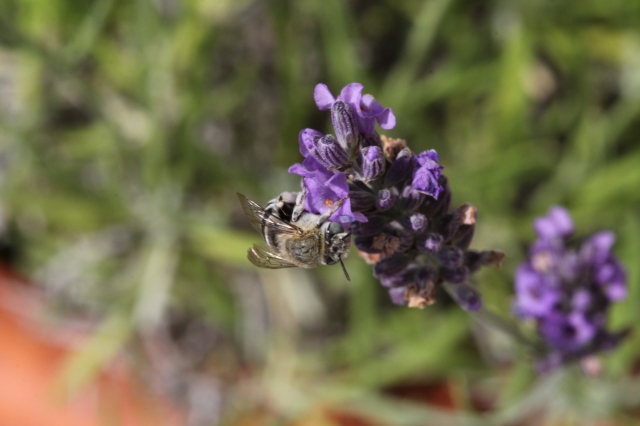
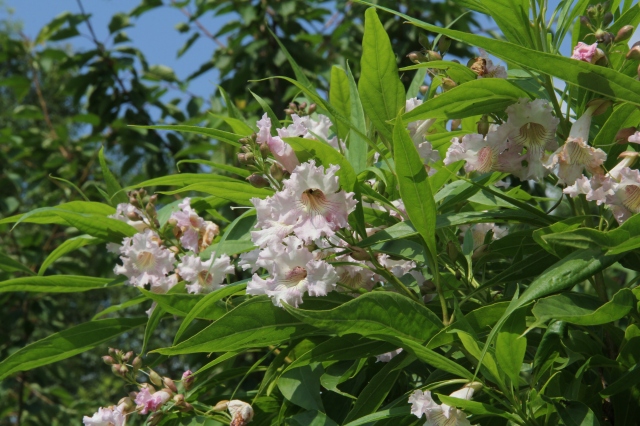
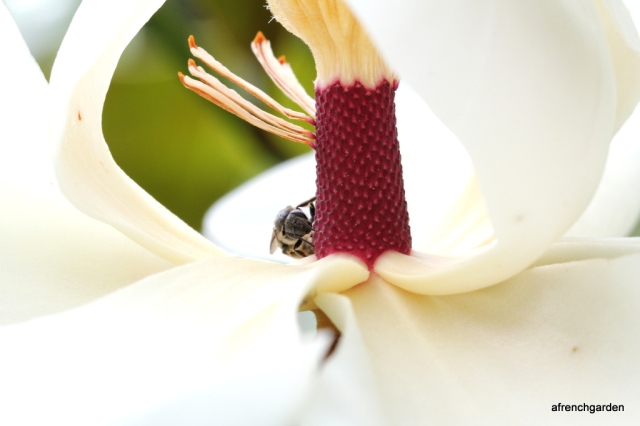
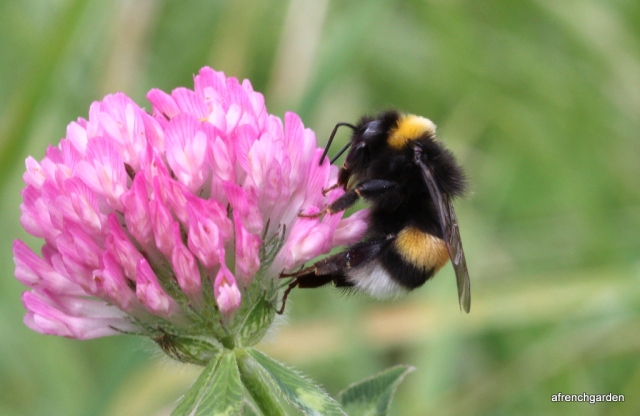




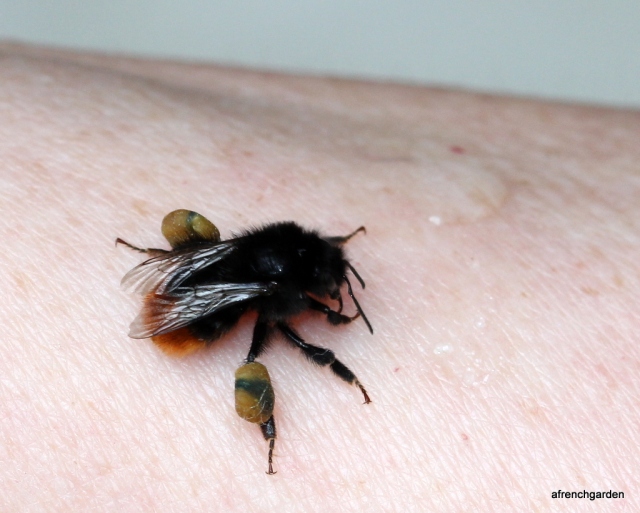
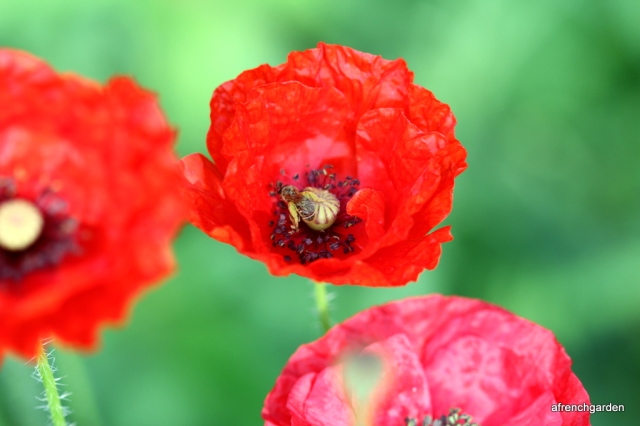
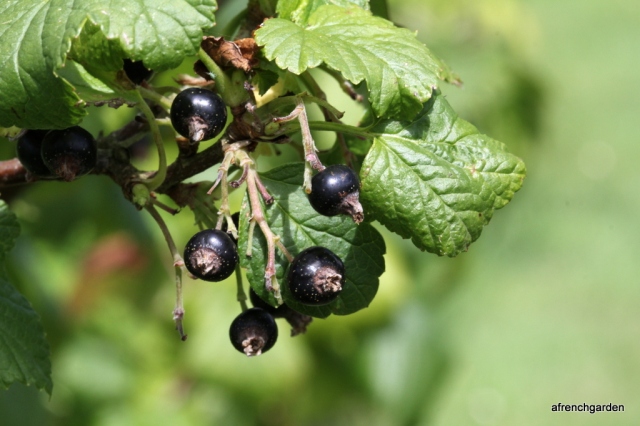

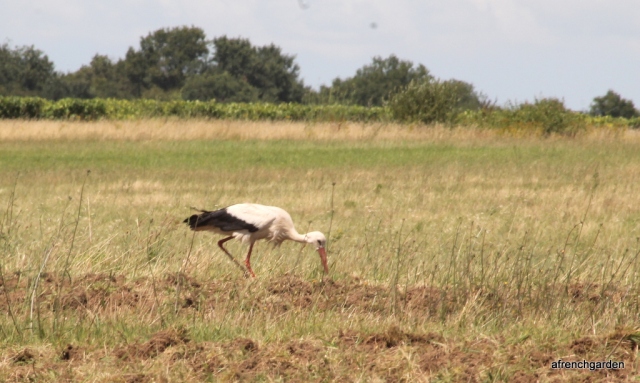


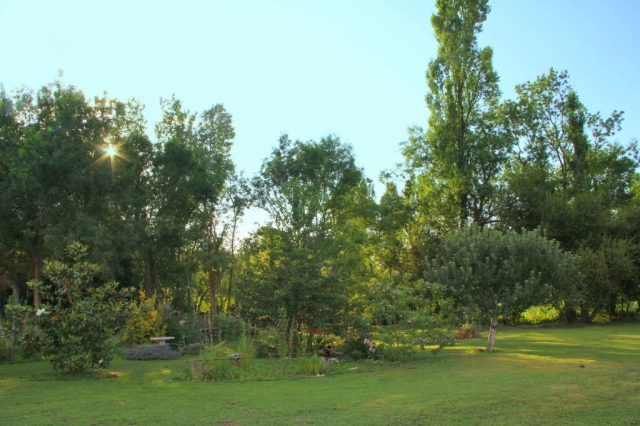
Your gorgeous images really give us a sense of the beauty of the summer there (and I am thrilled that you were able to capture some shots of the birds there). The idea of sorbet sounds wonderful as does the prospect of an extended vacation.
LikeLike
I am much better at making sorbet than taking pictures of birds. My blackcurrant sorbet is my best. I have not got a lens that allows me to take birds very far away and any time I get a camera out they go and sit behind lots of leaves – the bees are much friendlier. Amelia
LikeLike
I’m glad you’re seeing some good weather. We’re in our hot and muggy period.
The Chitalapa is interesting. I’ve never heard of the catalpa being crossed with another tree.
LikeLike
It seems a very successful hybrid as a Catalapa would be too big for the garden yet I can enjoy something very similar and I do try to chose plants that can survive without watering once they are established. Amelia
LikeLike
That photo of the magnolia flower with a bee is soooo beautiful. And I love the stork following in the tractor’s wake – lazy old thing, going for the easy meal 🙂 This post made me long for summer – I have about 3 months to wait!
LikeLike
I love my Magnolia tree, I planted it when it was very little and I had no idea how long it would take to flower. I did not even think about the bees back then so that is an additional bonus. Amelia
LikeLike
Did the wee bee recover after its double helping of sugar syrup?
LikeLike
It tucked away its sugar meal and was off! There was nothing wrong with it but I think it must have misjudged how much energy it would use taking that heavy pollen load back to the nest. Amelia
LikeLike
Excellent.
LikeLike
Love the photos of the tuckered out bumble 🙂
And you get Storks! Envy again!!
The raptor is definitely a Black Kite. They are one of the few species we get here that we also got in Australia. My father used to make us kids go and lie on the ground somewhere in the open to encourage them to investigate the ‘carrion’. Then he could get good photos or observe them closely.
Off topic, here is a link to a blog post about some promising new research into a native biological control for the Asian Hornet: <a href="http://wild-life-in-france.blogspot.com/2014/07/conops-vesicularis-and-asian-hornet.html"
LikeLike
Beautiful garden !
LikeLike
Thank you, Dominique. I am glad you like it, I enjoy sharing it. Amelia
LikeLike
Beautiful flowers, buzzing bees, exciting wildlife–Summer is the best!
LikeLike
All the seasons have their beauty – but I agree with you, summer is best! Amelia
LikeLike
Like New Hampshire Garden Solutions, I’m fascinated by the Chitalpa. What kind of soil have you got there to please it so? Your beautiful bee pictures always make me so happy when I see them – and you’ve been responsible for making me pay attention to the bees in my own garden so much more. Thanks!
LikeLike
Our soil here is chalky and sandy. It is never water-logged and does not retain water well. This is great for walking around us as we are never knee-deep in mud, but in the garden I try and choose plants that can withstand periods of dryness and have none that need wet conditions to survive. The Chitalapa is perfectly suited for dry conditions – that doesn’t mean it would not survive in damp soil, just that I have no experience of that. I’m glad you look at the bees more. I was walking with some friends near the vines a few days ago and I showed them the bees nests in the dry ground and the bees coming and going out of their nests and they had never noticed it before even though they have lived here all their lives. Amelia
LikeLike
Winter flowering cyclamen looking so fresh at this time of year. Go figure.
LikeLike
We may call them winter flowering but they don’t care! I think this summer and spring have been so mild and wet their corms are full of energy and bursting to flower and so don’t wait for winter. Amelia
LikeLike
Love the pollen bags, Amelia. Agree with Susan Walter – I think it’s a Black Kite too. RH
LikeLike
Thanks for the confirmation from a birdy person. Amelia
LikeLike
We have a lot of blackcurrants this year, some will be made in to coulis (good with ice cream or other fruit), some will be frozen to give a mid winter-hint of summer. Philip
LikeLike
Blackcurrant coulis on vanilla ice cream, that is very appealing. I think I should put some aside for the winter as you suggest. Amelia
LikeLike
All beautiful, but especially the Chitalpa. Roll on holiday time!
LikeLike
I’ve had a great week beside Lake Carcans so now its back to the garden! Amelia
LikeLike
Certainly looks like a kite, Amelia but as we only have red ones here I can’t tell you whether it is a black one. I tried growing oleander (in a pot) but it never thrived and mainly just looked an embarrassment. Dave
LikeLike
I’ve had black Kites pointed out to me in France so thanks for the back up ID. Oleander does need a milder climate and if it has that it doesn’t ask for much more. It’s lovely to see them where they are happy. Amelia
LikeLike
I have a white cyclamen in a pot and that’s flowering! I have no idea why, it isn’t that cold here! Fun to see all the birds too.
LikeLike
Isn’t that strange! I am just back from a week away and I have noticed another cyclamen sprouting just a single flower but no leaves. Amelia
LikeLike
Beautiful photos and I envy the way you live there.
LikeLike
Thanks Marie. I love my garden and my bees but there are always frustrations in a garden too. Today (19.7.14, back from holiday, there have been thunderstorms and more forecast. The grass is long and wet and the weeds even taller! Amelia
LikeLike
Yes, looks like a black kite to me too. I like your mention of giving the tired bee a feed, think I’ll try it next time I see one out in the garden. Nice one.
LikeLike
I frequently give tired bees a feed and they soon recover. They seem to over tire themselves sometimes but a bit of sugar and water and they are soon off again. Amelia
LikeLike
Hello Amelia,
The heat almost hits you from all these summery images on screen. Is it turning into a hotter drier than average summer, or par for the course? And I wonder if irrigating the garden ever becomes a big issue?
BW
Julian
LikeLike
This year continues to be unusual. I have been only watering the vegetable garden when necessary because we have had so much rain. However, we have also had warm temperatures and lots of sunshine. Usually the grass doesn’t need cutting much in the summer and there are generally a lot less weeds. I’ve no complaints as I like the warmth and sunshine and usually we do have to water in the evening so it is saving us work. Amelia
LikeLike
We have definitely had a lot less watering to do this year. Another major storm hit us today, complete with hailstones. Everything seems to have survived ok though!
LikeLike
We had a thunderstorm today too, no damage but 16 mm. of rain – just what the garden needed! Amelia
LikeLike